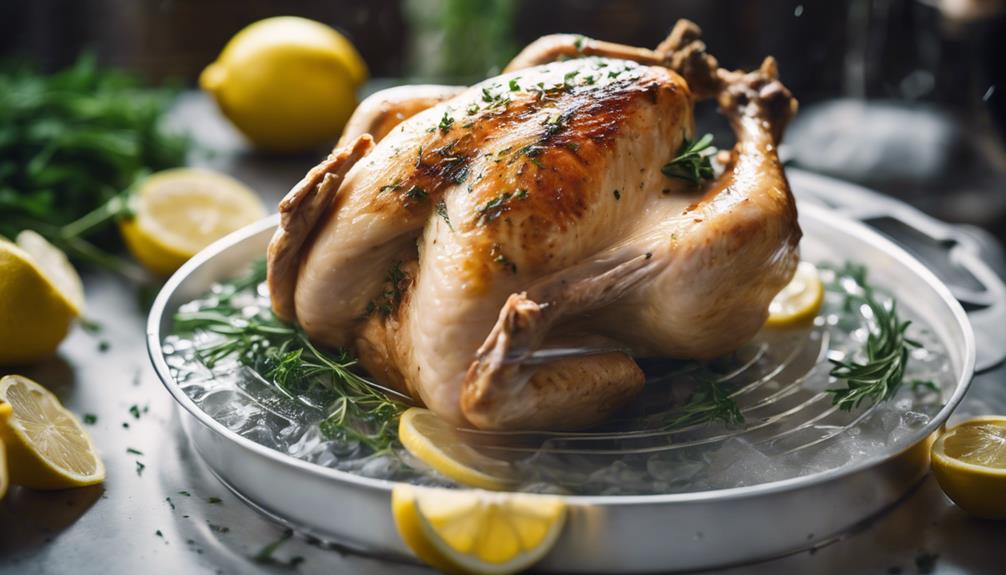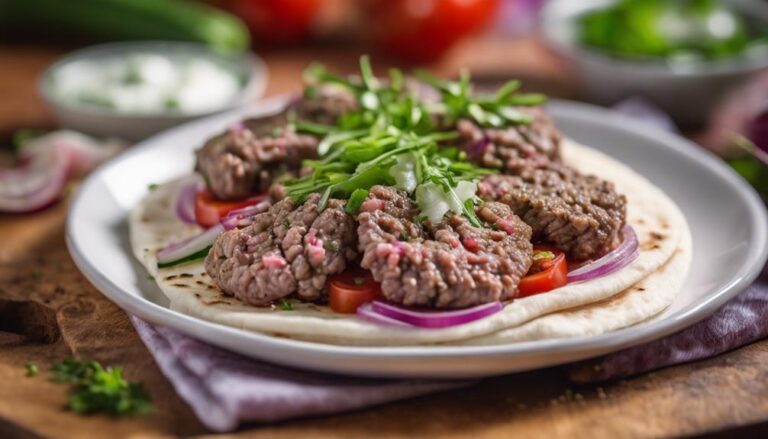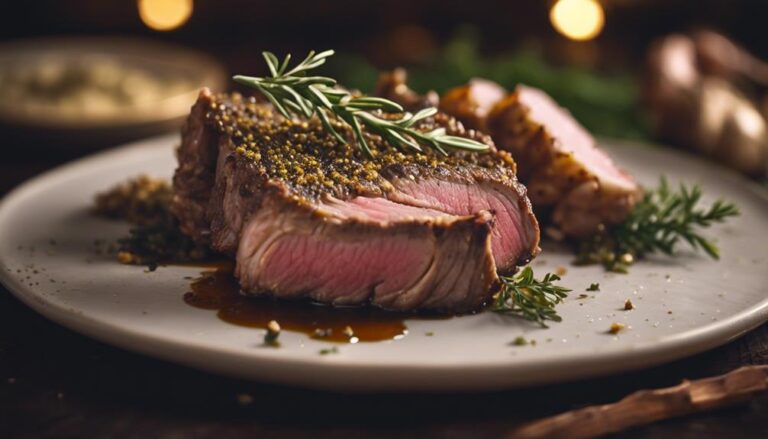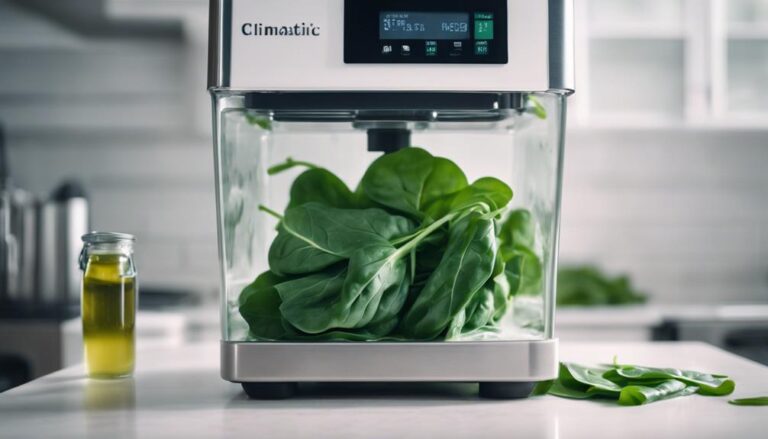Sous Vide Grilled Whole Chicken With Lemon Herb Seasoning
Experience the succulent fusion of sous vide technique and vibrant lemon herb seasoning transforming your whole grilled chicken into a culinary masterpiece. Achieve unparalleled juiciness and tenderness with precise sous vide cooking, sealing in natural flavors. Elevate your dish with a blend of rosemary, thyme, garlic, and zesty lemon zest, enhancing every bite. Uncover the secrets behind perfectly cooked chicken and discover expert tips for flavor infusion and safety in every mouthwatering bite. Elevate your grilling game with this tantalizing sous vide lemon herb chicken.
What You Will Learn Here
- Sous vide cooking ensures perfectly cooked and juicy whole chicken.
- Lemon herb seasoning enhances flavor profile of the grilled chicken.
- Preheat grill properly and pat chicken dry for optimal results.
- Use a food thermometer to ensure safe internal temperature of 165°F.
- Infuse flavors like rosemary, thyme, and garlic for a delicious dish.
Cooking Method Origins
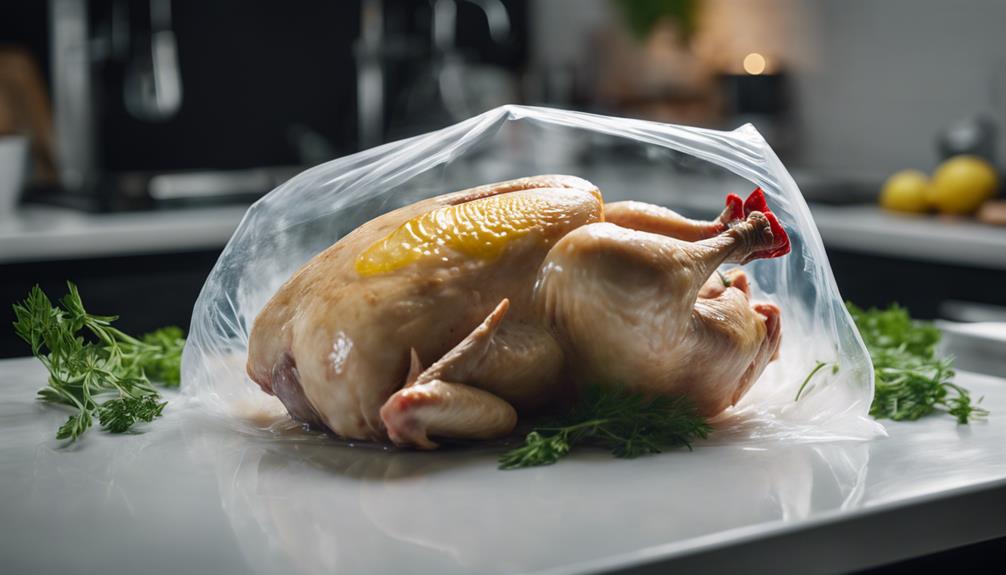
Discover the roots of the sous vide technique and how it has evolved over time.
Explore the historical background that led to the development of this cooking method.
Uncover the modern applications that have made sous vide a popular choice in kitchens worldwide.
Sous Vide Technique
The origins of the Sous Vide cooking technique can be traced back to the 1970s when it was first developed by French chefs looking to achieve precise temperature control for delicate dishes. Sous vide benefits include precision cooking, ensuring that food is cooked evenly from edge to edge. This method involves vacuum-sealing ingredients in a bag and cooking them in a water bath at a controlled temperature. The key equipment needed for sous vide cooking is an immersion circulator, which regulates the water temperature with accuracy. This technique is favored by many chefs for its ability to maintain the natural flavors and nutrients of the ingredients, resulting in consistently delicious meals.
| Sous Vide Benefits | Sous Vide Equipment |
|---|---|
| Precision cooking | Immersion circulator |
Historical Background
As the Sous Vide technique gained traction among chefs seeking precise temperature control for their dishes in the 1970s, its historical roots can be traced back to a quest for culinary innovation. Culinary evolution played a significant role in the development of this cooking method, which diverged from traditional methods by introducing a more controlled and consistent approach to cooking.
Cultural influences also shaped Sous Vide, with chefs from around the world contributing their techniques and flavors to this global culinary trend. The process of vacuum-sealing food and immersing it in a precisely heated water bath revolutionized cooking by ensuring ideal results.
These historical foundations laid the groundwork for the modern applications of Sous Vide in today's culinary landscape.
Modern Applications
Exploring the culinary landscape today, modern applications of the Sous Vide cooking method reveal its innovative origins rooted in a quest for precision and consistency. Sous vide benefits include precise temperature control, resulting in perfectly cooked dishes every time. This method also allows for enhanced flavors as ingredients are vacuum-sealed, preserving their natural juices and aromas. However, one of the disadvantages of sous vide is that it requires longer cooking times compared to traditional methods, which may not always align with time-sensitive meal preparations. To overcome this, chefs have developed various flavor infusion techniques to elevate dishes, such as adding herbs, spices, or citrus peels to the sous vide bags, enhancing the overall taste profile. The table below summarizes some key aspects of sous vide cooking:
| Aspect | Description |
|---|---|
| Sous Vide Benefits | – Precise temperature control |
| – Enhanced flavors through vacuum-sealing | |
| Sous Vide Disadvantages | – Longer cooking times |
| Sous Vide Flavor Infusion Techniques | – Adding herbs, spices, or citrus peels to bags |
Key Seasoning Components
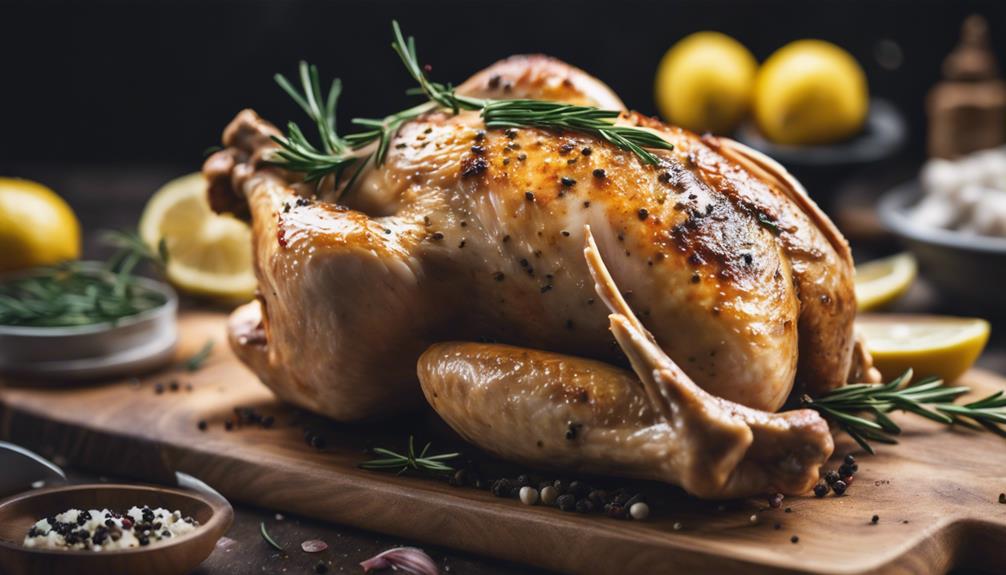
Using a combination of aromatic herbs and bold spices gives depth and complexity to the flavor profile of the grilled whole chicken. When considering herb combinations and flavor pairings for seasoning your chicken, think about the following:
- Rosemary and Thyme: These classic herbs bring a woody and earthy undertone to the chicken, enhancing its natural flavors and adding a touch of freshness.
- Garlic and Paprika: The pungent aroma of garlic combined with the smoky sweetness of paprika creates a flavorful crust on the chicken, elevating its taste to a whole new level.
- Lemon Zest and Parsley: Bright and zesty, lemon zest paired with the fresh, slightly peppery taste of parsley adds a burst of citrusy freshness that cuts through the richness of the chicken, balancing the overall dish.
Carefully selecting and combining these key seasoning components will ensure that your grilled whole chicken is bursting with a harmonious blend of flavors that will leave your taste buds craving more.
Tasty Chicken Dish Ideas
Looking for new ways to elevate your chicken dishes?
Try out some delicious options like Lemon Pepper Roasted Chicken, Sous Vide Chicken Thighs, and Sous Vide Lemon Chicken Breast.
Each dish offers a unique blend of flavors and textures that will surely delight your taste buds and impress your guests.
Get ready to take your chicken game to the next level with these tantalizing recipes.
Lemon Pepper Roasted Chicken
Enhance your culinary repertoire with the flavorful and aromatic Lemon Pepper Roasted Chicken – a delightful dish that will tantalize your taste buds with its zesty seasoning and succulent meat. Imagine the perfect blend of tangy lemon, bold pepper, and tender chicken coming together in a harmonious symphony of flavors.
- Crispy Skin: Picture the chicken skin perfectly seasoned and roasted to a beautiful golden brown, adding a satisfying crunch to every bite.
- Juicy Meat: Visualize cutting into the chicken to reveal moist, juicy meat that practically falls off the bone, ensuring a mouthwatering experience.
- Balanced Flavors: Envision the balance between the brightness of lemon and the warmth of pepper, creating a sensation that dances on your palate.
Sous Vide Chicken Thighs
Elevate your chicken game with the tender and flavorful Sous Vide Chicken Thighs – a succulent dish that promises to impress your taste buds with every bite. Cooking chicken thighs sous vide offers a myriad of benefits, enhancing the taste and texture of the meat.
Here's why you should consider sous vide for your next chicken dish:
- Juicy Perfection: Sous vide guarantees your chicken thighs are cooked to juicy perfection, locking in all the flavors and juices.
- Consistent Results: With sous vide, you can achieve reliable results every time, ensuring your chicken thighs are never overcooked or dry.
- Tender Texture: The gentle cooking process of sous vide results in incredibly tender chicken thighs that melt in your mouth.
When comparing sous vide to grilling, the sous vide method often leads to a more tender and flavorful outcome.
Sous Vide Lemon Chicken Breast
Indulge in a succulent culinary experience with Sous Vide Lemon Chicken Breast, a tantalizing dish that promises to awaken your taste buds with vibrant citrus flavors and tender, juicy chicken. The infusion of lemon herb marinade guarantees each bite bursts with zesty freshness, elevating the chicken's natural juiciness to new heights. Achieving grilled chicken perfection has never been easier with the sous vide method, where precision cooking results in a moist and flavorful dish every time.
- Tender chicken breast infused with a tangy lemon herb marinade.
- Juicy, succulent meat that melts in your mouth with every bite.
- Perfectly grilled exterior that locks in the citrusy flavors and juices, creating a harmonious blend of taste and texture.
Chicken Temperature Safety
When cooking chicken, it's important to make sure that it reaches safe internal temperatures to prevent foodborne illnesses.
Always use a reliable thermometer to check that the chicken is cooked thoroughly.
Following proper temperature guidelines is essential for safe and delicious chicken dishes.
Safe Chicken Cooking Temperatures
To guarantee chicken is safe to eat, always cook it to the recommended internal temperatures. When it comes to poultry preparation, temperature guidelines are essential for kitchen safety when cooking poultry. The USDA recommends cooking chicken to an internal temperature of 165°F (73.9°C) to kill harmful bacteria like salmonella.
Using a food thermometer is the most reliable way to make sure your chicken reaches the correct temperature. Insert the thermometer into the thickest part of the meat without touching bone for an accurate reading. Remember, even if the chicken looks well-cooked on the outside, it may still be undercooked inside.
Preventing Foodborne Illnesses
Ensuring the safety of your chicken dishes begins with properly monitoring and maintaining the cooking temperatures to prevent foodborne illnesses.
When handling raw chicken, preventing cross-contamination is vital. Make sure to wash your hands thoroughly with soap and water before and after touching raw chicken to avoid spreading harmful bacteria. Proper handwashing techniques involve scrubbing your hands for at least 20 seconds, including the backs of your hands, between your fingers, and under your nails.
Remember to also clean any surfaces or utensils that come into contact with raw chicken.
Thermometer Usage Tips
Properly checking the internal temperature of your grilled whole chicken is vital to guaranteeing its safety and deliciousness.
When using a meat thermometer, make sure it's inserted into the thickest part of the chicken without touching bone for an accurate reading.
The United States Department of Agriculture (USDA) recommends a minimum internal temperature of 165°F (74°C) for poultry to ensure meat doneness and kill harmful bacteria.
Remember that cooking times can vary based on the size of the chicken, so it's important to monitor the temperature throughout the cooking process.
Final Thoughts
Consider reflecting on the overall cooking experience and flavors achieved before deciding if this Sous Vide Grilled Whole Chicken Recipe is a new favorite in your culinary repertoire. The Sous Vide method offers significant benefits by ensuring the chicken cooks evenly and stays juicy throughout. The flavors infused during the sous vide process are locked in, resulting in a tender and flavorful meat that melts in your mouth. The lemon herb seasoning adds a revitalizing zing to the dish, complementing the natural taste of the chicken beautifully.
When it comes to grilling techniques, ensuring a properly preheated grill is essential to achieving those coveted grill marks and a delightful charred aroma. Remember to pat the chicken dry before grilling to promote browning and avoid excessive smoke. Additionally, mastering the art of flipping the chicken at the right time contributes to an evenly cooked and visually appealing dish.
Frequently Asked Questions
Can I Use a Regular Grill Instead of Sous Vide for This Recipe?
Yes, you can use a regular grill for this recipe. The grilling techniques will differ from sous vide, but the flavors will still shine through. Adjust cooking methods for the grill, ensuring the chicken is cooked thoroughly while maintaining the desired taste.
What Type of Herbs Can I Substitute for the Lemon Herb Seasoning?
For the lemon herb seasoning substitute, try a mix of rosemary, thyme, basil, or oregano. Cilantro, parsley, dill, or sage can also add unique flavors. Experiment with different combinations to enhance your dish.
Can I Use the Lemon Herb Seasoning on Other Meats Besides Chicken?
Yes, you can use the lemon herb seasoning on other meats like pork, fish, or even vegetables. Experiment with different flavors and cooking techniques to create unique dishes. It's versatile and adds a zesty kick to your meals.
Is It Safe to Eat Slightly Pink Chicken if Cooked Sous Vide?
When cooking chicken sous vide, make sure it reaches the recommended internal temperature for food safety. Even if slightly pink, sous vide chicken is safe to eat as long as it has been cooked properly.
Can I Refrigerate Leftover Sous Vide Chicken for Later Consumption?
To store leftover sous vide chicken properly for later, refrigerate it promptly. When reheating, make sure it reaches a safe temperature. For long-term storage, freezing is an option to preserve flavor. Follow recommended guidelines for best results.
Conclusion
Indulge in the juicy tenderness of sous vide grilled whole chicken with zesty lemon herb seasoning. This culinary technique guarantees perfectly cooked chicken every time, while the blend of herbs and citrus adds a burst of flavor.
Elevate your cooking game with this delicious dish that's both easy to prepare and guaranteed to impress your taste buds. Say goodbye to dry, overcooked chicken and hello to a mouthwatering meal that will leave you craving more.
Bon appétit!
